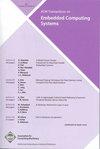边缘AI加速的无溢出计算内存
IF 2.8
3区 计算机科学
Q2 COMPUTER SCIENCE, HARDWARE & ARCHITECTURE
引用次数: 0
摘要
计算存储器是扩充了专用逻辑以支持算术的存储器阵列。它们支持以数据为中心的计算模式的有效执行,例如那些表征人工智能(AI)算法的模式。这些架构可以提供计算能力作为内存阵列结构的一部分(In-Memory computing, IMC)或在其直接外围(Near-Memory computing, NMC)。通过将处理元素置于(或非常接近)存储器中,计算存储器可以将数据访问的成本降至最低。此外,通过利用内存阵列的规则结构,可以实现高度并行(因此是高性能)的计算。然而,内存元素的常规布局也限制了输入和输出的数据范围,因为存储在每个地址的操作数和结果的位宽不能自由改变。为了应对这一挑战,我们在此提出了一种硬件/软件协同设计方法,将谨慎的逐层量化和层间缩放与轻量级硬件支持相结合,以实现点向量操作的无溢出计算。我们演示了它们在实现人工智能模型的卷积和完全连接层中的应用。我们以两种实现方式体现我们的战略,分别基于IMC和NMC。实验结果表明,当与2KB子阵列接口时,仅需要10.5%(对于IMC)和12.9%(对于NMC)的面积开销。此外,对基准cnn的推断显示,由于等效浮点实现的量化,精度下降可以忽略不计。本文章由计算机程序翻译,如有差异,请以英文原文为准。
Overflow-free Compute Memories for Edge AI Acceleration
Compute memories are memory arrays augmented with dedicated logic to support arithmetic. They support the efficient execution of data-centric computing patterns, such as those characterizing Artificial Intelligence (AI) algorithms. These architectures can provide computing capabilities as part of the memory array structures (In-Memory Computing, IMC) or at their immediate periphery (Near-Memory Computing, NMC). By bringing the processing elements inside (or very close to) storage, compute memories minimize the cost of data access. Moreover, highly parallel (and, hence, high-performance) computations are enabled by exploiting the regular structure of memory arrays. However, the regular layout of memory elements also constrains the data range of inputs and outputs, since the bitwidths of operands and results stored at each address cannot be freely varied. Addressing this challenge, we herein propose a HW/SW co-design methodology combining careful per-layer quantization and inter-layer scaling with lightweight hardware support for overflow-free computation of dot-vector operations. We demonstrate their use to implement the convolutional and fully connected layers of AI models. We embody our strategy in two implementations, based on IMC and NMC, respectively. Experimental results highlight that an area overhead of only 10.5% (for IMC) and 12.9% (for NMC) is required when interfacing with a 2KB subarray. Furthermore, inferences on benchmark CNNs show negligible accuracy degradation due to quantization for equivalent floating-point implementations.
求助全文
通过发布文献求助,成功后即可免费获取论文全文。
去求助
来源期刊

ACM Transactions on Embedded Computing Systems
工程技术-计算机:软件工程
CiteScore
3.70
自引率
0.00%
发文量
138
审稿时长
6 months
期刊介绍:
The design of embedded computing systems, both the software and hardware, increasingly relies on sophisticated algorithms, analytical models, and methodologies. ACM Transactions on Embedded Computing Systems (TECS) aims to present the leading work relating to the analysis, design, behavior, and experience with embedded computing systems.
 求助内容:
求助内容: 应助结果提醒方式:
应助结果提醒方式:


